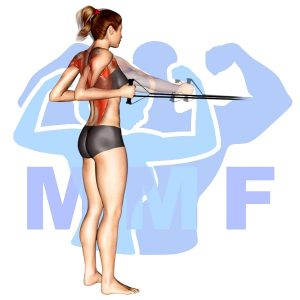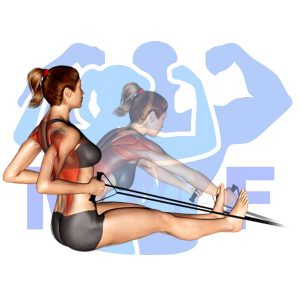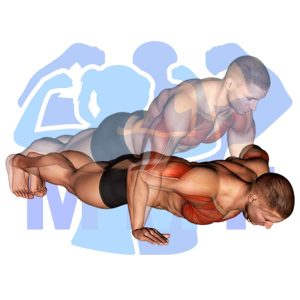Do you often experience shoulder pain or discomfort when performing upper body exercises? If so, you may be suffering from a common issue related to weak rotator cuff muscles. Fortunately, there is a simple and effective solution to this problem: resistance band external shoulder rotations. In this post, we will guide you through the benefits of incorporating this exercise into your workout routine and provide step-by-step instructions on how to perform it correctly to help alleviate your shoulder pain and prevent future injury. So, let’s dive in and get started!
Resistance Band External Shoulder Rotation Summary
- Primary Muscles: Infraspinatus
- Secondary Muscles: Deltoid – Posterior, and Teres Minor
- Equipment: Resistance band and door anchor
- Mechanics Type: Isolation
- Force: Push
- Utility: Auxiliary

Resistance Band External Shoulder Rotation Instructions
- Attach the resistance bands to an anchor point as close to the height of your elbow when standing as possible. If you attach the band to a lower point, you can sit in a chair or squat. Your goal is to have the band tension perpendicular to your rotation path the height of your elbow.
- Grab the band handles with both hands while facing the anchor point. Stand so that the band and arm performing the action is resting across your stomach.
- Now pull the band tight with your resting hand.
- To execute, pull the band as far away from your torso as possible by externally rotating your shoulder. Keeping your forearm parallel to the ground.
- Return your arm back to the starting position.
- Repeat for your desired number of reps and then switch arms.
Video Tutorial
Resistance Band External Shoulder Rotation Muscles
Target (Agonist)
- Infraspinatus
Synergists
Dynamic Stabilizers
- None
Stabilizers
Antagonist Stabilizers
- None

Benefits of Resistance Band External Shoulder Rotation
The Resistance Band External Shoulder Rotation is a great exercise for building strength in the infraspinatus muscle. This muscle is responsible for external rotation of the shoulder, and strengthening it can help improve posture, reduce shoulder pain, and improve shoulder mobility. Additionally, this exercise can help to improve the stability of the shoulder joint, reduce the risk of injury, and increase overall strength in the shoulder. Moreover, this exercise requires very little equipment and can easily be done at home or in the gym.
Tips for Performing Resistance Band External Shoulder Rotation
When you wish to attain the optimum outcomes, implement these straightforward tips. Furthermore, if you would like to avoid injuries, follow these tips.
- Make sure The Resistance Band Are Tight. Before you start the workout ensure the bands are not sagging.
- Perform The Proper Amount Of Sets Using Rest. Your goal, to begin with, might be to do 3 sets to near failure. Nevertheless, you can raise to 5 sets. If your muscle tissue isn’t fatigued at the end of 3 – 5, something ought to change. Initally you can increase the resistance to make each rep harder. Second, you can reduce the rest time in between each set.
- Make Use Of A Mirror If Available To Observe Your Form. You may well experience a little vain looking in a mirror while you are doing exercises, but you are not checking yourself out, you are insuring your form is strong.
- Slow Each Rep Down For Improved Strength Gains. By Raising the time under tension, you are engaging your muscles longer, and they will respond by increasing strength. You can accomplish this without raising the weight by doing slow reps about 4 – 6 seconds contraction and pause then 4 – 6 seconds expanding.
Benefits and Tips Video
Frequent Mistakes To Avoid
You have to stay clear of these fairly typical mistakes to manage good form and improved tonning. Llikewise
- Don’t go to fast. Moving fast here can quickly lead to a shoulder injury.
- Don’t allow the band to be anything by perpendicular to your body. If the band is a weird angle so is the tension in your shoulder, this can also lead to an injury.
- Avoid Using Too Little or Too Much Resistance. Not enough, and you will not be adequately using your main muscle, more than the right amount, and you will likely need to cheat. Ensure that you can conduct between 8-12 reps with proper form.
Find More Resistance Band Exercises Here
Variations and Complementary Exercises
For those who wish to add more variety to their routine, or who would like to try complementary or alternative exercises to Resistance Band External Shoulder Rotation, there are several options available. Below is a list of variations, complementary, and alternative exercises that work similar muscles.
Resistance Band Straight Back Seated Rows

Resistance Band Straight Back Seated Rows are an excellent complementary exercise for Resistance Band External Shoulder Rotations. This exercise works the back and shoulder muscles from a seated position and adds stability to the shoulder and rotator cuff. The bands provide resistance in both directions, and the seated position allows for better control of the movement. This exercise helps to strengthen the back muscles, improve posture, and provide additional stability to the shoulder joint. It is a great alternative to traditional weights for individuals looking for a more effective workout.
Resistance Band Standing Rows

Resistance Band Standing Rows can be a great complementary or alternative exercise to Resistance Band External Shoulder Rotation. This exercise strengthens the muscles of the back, shoulders, and arms. It works the muscles of the back by drawing the band towards the body while keeping the arms straight and the back flat. It works the shoulders by bringing the elbows up and back towards the body while keeping the arms straight. It works the arms by pulling the band with bent elbows and straight wrists. Resistance Band Standing Rows also helps to improve posture, balance, and stability which are essential for any exercise program.
Resistance Band Seated Rows

Resistance Band Seated Rows are an excellent alternative or complementary exercise to Resistance Band External Shoulder Rotations. This exercise works the back, shoulders, and arms. It also helps to improve posture and increase core strength. To perform this exercise, sit on the floor with the feet flat and the knees bent. Place a resistance band under the feet and grip it in both hands. Keeping the arms straight, pull the band towards the chest while squeezing the shoulder blades together. Hold for a few seconds before slowly releasing and returning to the starting position. This exercise is great for strengthening the back, improving posture, and building core strength.
Check Out These Top Resistance Band Exercises
Resistance Band Face Pulls

Resistance Band Face Pulls are a great complementary or alternative exercise to Resistance Band External Shoulder Rotations. Resistance Band Face Pulls target the muscles in the back of the shoulder and upper back, while Resistance Band External Shoulder Rotations target the muscles in the front of the shoulder. Resistance Band Face Pulls involve holding a resistance band in each hand and pulling it towards your face. This movement will help strengthen your rear deltoids and upper back muscles, which are essential for shoulder health and stability. Additionally, Resistance Band Face Pulls can be modified to create a variety of different exercises, such as reverse flys, single-arm rows, and more.
Resistance Band Bent Over Shoulder Rows

Resistance Band Bent Over Shoulder Rows are a great complementary or alternative exercise to Resistance Band External Shoulder Rotations. This exercise targets the middle and rear deltoids, rhomboids, and trapezius muscles, while also engaging the core. To do this exercise, you must start by standing with your feet shoulder-width apart, holding the resistance band in both hands. Bend forward at the waist while keeping your back straight and parallel to the floor. Next, pull the resistance band back towards your body as you squeeze your shoulder blades together. Hold for a moment before slowly releasing the tension. This exercise will help you build strength and stability in your shoulder muscles and improve your posture.
Resistance Band Bent Over Shoulder Rows

Resistance Band Bent Over Shoulder Rows can be a great complementary or alternative exercise to Resistance Band External Shoulder Rotations. This exercise is performed by standing on the resistance band with feet shoulder-width apart and slightly bent at the knees. Holding the handles in each hand, bend forward from the hips until the torso is almost parallel to the ground. Next, keeping the elbows close to the body, pull the handles back and up towards the armpits. Hold for a few seconds and then slowly release back to the starting position. This exercise works the back muscles, specifically targeting the rhomboids, as well as strengthening and stabilizing the shoulder joint. It is a great way to provide balance to Resistance Band External Shoulder Rotations, which work the rotator cuff muscles and help to improve shoulder mobility.
Find More Shoulders Exercises Here
Opposing Complementary Exercises
In addition to the Resistance Band External Shoulder Rotation, there are a number of other exercises that work the opposing muscle groups in order to further strengthen the shoulder area. Here are some exercises that work the opposite muscles as the Resistance Band External Shoulder Rotation:
Standing Cable Chest Press

The Standing Cable Chest Press is an excellent exercise to pair with the Resistance Band External Shoulder Rotation. This exercise utilizes the opposing muscle group of the shoulders, the chest. The Standing Cable Chest Press helps to develop strength in the chest muscles, while the Resistance Band External Shoulder Rotation helps to develop strength in the shoulder muscles. This pairing of exercises creates balance in the upper body and helps to reduce the risk of injury. When done correctly, these two exercises can help build strength and improve overall upper body fitness.
Push Ups

Push ups are an excellent complementary exercise to Resistance Band External Shoulder Rotation, as it works the opposing muscle group. Push ups are an upper body exercise that require you to lift your own body weight off the ground, engaging your chest, triceps, and shoulder muscles. By doing this exercise in combination with Resistance Band External Shoulder Rotation, you will be able to strengthen both sets of muscles and work them in opposing directions. This will help to increase overall stability and strength in your shoulder muscles, making them better able to handle everyday activities.
Push Up From Knees

Push Up From Knees is an effective exercise to strengthen the muscles of the chest, shoulders, and triceps. It is a great complement to Resistance Band External Shoulder Rotation, as it works the opposite muscle group of the shoulders. This exercise helps to build strength in the back and rear deltoids, which in turn helps balance out the muscles in the shoulder area and prevent injury. By doing both exercises in succession, you are able to create a comprehensive workout that targets all of the muscles in the shoulder region.
Transform Your Shoulders with Resistance Bands
Resistance bands are a popular and effective tool for targeting several muscle groups, including the shoulders. External shoulder rotation exercises with resistance bands can help you to build and tone the muscles around the shoulder, leading to a more defined and sculpted appearance. Not only does this exercise help for aesthetic purposes, but also aids with injury prevention by strengthening key muscles that support your shoulder joint. Whether you are new to resistance bands or have been using them for a while, incorporating external shoulder rotation exercises can be a great addition to your shoulder routines.
References: Wikipedia | ExRx.net | PubMed.gov | Comprehensive List of Shoulders Resistance Band Exercises

